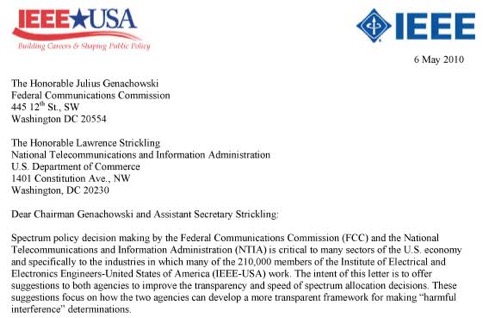IEEE-USA Writes to FCC & NTIA on Clarifying Harmful Interference

Yesterday, IEEE-USA sent a letter to both FCC and NTIA urging them to work together in clarifying the present definition of “harmful interference”. IEEE-USA is part of the IEEE, the world's largest technical professional society with over 395,000 members in over 160 countries and advances the public good and promotes the careers and public policy interests of more than 210,000 engineers, scientists and allied professionals who are U.S. members of the IEEE. (The above copy of the first paragraph is a link to the whole 4 page document.)
“Harmful interference”/HI is the traditional criterion FCC has used for determining whether interference from anew service to an incumbent service will be tolerable. It is also used 5 times in the Communications Act in a similar way. However, the definition is a 30 word sentence from the ITU Radio Regulations that is ambiguous in many situations. Thus HI determinations have been often been lengthly and expensive to participate in. For example, the Commission has been deliberating more than 4 years on whether TDD use of the AWS-3 band would cause HI to the lower adjacent 3G downlink band.
We have written previously about both the difficultly of defining HI and its importance after the Spectrum Inventory for identifying new spectrum that can be used without causing HI to incumbents. While an unambiguous definition of HI is impractical, any clarification and simplification for the process for making an HI determination will greatly speed up the availability of spectrum for new services and thus speed technical innovation.
Some quotes from the letter:
Uncertainties like this discourage capital formation for new radio technologies. Such uncertainties also affect capital formation for incumbents in determining how much protection they are entitled to from later entrants.
...
ITU-R M.1635 states that “Parts of the assessment procedures need to be based on a statistical methodology, well known as the Monte Carlo technique.” The UK’s national spectrum manager, Ofcom, has also advocated and frequently used statistical technique in spectrum policy decisions.2 Statistical techniques have been used by both FCC and NTIA in authorizing point-to-point fixed links where weather-related propagation losses are time variable3, and by FCC in authorizing broadcast stations because the Grade B contours include a statistical factor.
FCC and NTIA do not have a general policy on the use of statistical techniques in interference prediction even though many of the most contentious issues in recent years have focused on such issues. But no general guidance exists on how to extrapolate to cases involving other propagation phenomenon or mobile stations. Your agencies are in a position to begin to create such guidance.



![Validate my RSS feed [Valid RSS]](valid-rss-rogers.png)

